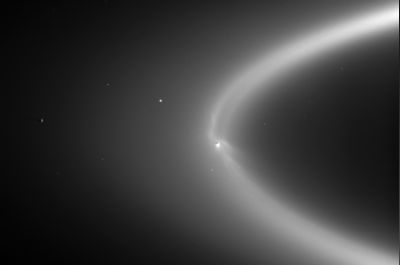The imagery from Cassini’s twelve-hour pass behind Saturn turns out to have been productive indeed. We pause from things interstellar, then, to admire the beautiful photograph below. The occultation of the Sun put the spacecraft in position to see the rings with exquisite and detail-enhancing backlighting, providing striking visual evidence for their extensive interaction with some of Saturn’s smaller moons.
Image (click to enlarge): Wispy fingers of bright, icy particles reach several tens of thousands of kilometers outward from Enceladus into the E ring, while the moon’s active south polar jets continue to fire away. Credit: Jet Propulsion Laboratory/Space Science Institute.
This is Enceladus as we’ve never seen it before, moving through a highly visible E ring, to which it appears connected by feathery strands of ice crystals. These are surely coming from the moon’s south polar geysers, another of Cassini’s remarkable discoveries. No clearer evidence that moons like this one have a role in shaping the rings through which they move could possibly be offered.
It’s the backlighting, of course, that teases out the level of detail in this image, showing microscopic particles that would otherwise be all but invisible. The E ring itself, Saturn’s outermost ring, had only been imaged in sections until now, but the occultation allowed Cassini to map its structure in great detail. Another significant find: a new, diffuse ring found outside the brighter main rings (and inside the G and E rings) that coincides with the orbits of Janus and Epimetheus. Here the process at work seems to involve debris from impacts on the two moons, a stream of fine particles that continue to feed the ring.



Theory of the rotation of Janus and Epimetheus
Authors: B. Noyelles
(Submitted on 24 Dec 2009)
Abstract: The Saturnian coorbital satellites Janus and Epimetheus present a unique dynamical configuration in the Solar System, because of high-amplitude horseshoe orbits, due to a mass ratio of order unity. As a consequence, they swap their orbits every 4 years, while their orbital periods is about 0.695 days.
Recently, Tiscareno et al.(2009) got observational informations on the shapes and the rotational states of these satellites. In particular, they detected an offset in the expected equilibrium position of Janus, and a large libration of Epimetheus.
We here propose to give a 3-dimensional theory of the rotation of these satellites in using these observed data, and to compare it to the observed rotations. We consider the two satellites as triaxial rigid bodies, and we perform numerical integrations of the system in assuming the free librations as damped.
The periods of the three free librations we get, associated with the 3 dimensions, are respectively 1.267, 2.179 and 2.098 days for Janus, and 0.747, 1.804 and 5.542 days for Epimetheus. The proximity of 0.747 days to the orbital period causes a high sensitivity of the librations of Epimetheus to the moments of inertia.
Our theory explains the amplitude of the librations of Janus and the error bars of the librations of Epimetheus, but not an observed offset in the orientation of Janus.
Comments: Accepted for publication in Icarus
Subjects: Earth and Planetary Astrophysics (astro-ph.EP)
Cite as: arXiv:0912.4830v1 [astro-ph.EP]
Submission history
From: Benoît Noyelles [view email]
[v1] Thu, 24 Dec 2009 11:06:23 GMT (303kb)
http://arxiv.org/abs/0912.4830